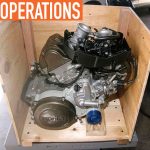Before any changes take place, before you install any new computer system, before you improve your new vehicle specification, you must measure your fleet’s current effectiveness and performance. These financial and other numeric measures should be trended on a monthly basis and summarized yearly. Make the information and charts public and, most importantly, discuss the trend charts at a monthly meeting.
One of the issues with top management is proving that a month’s performance is actually an improvement, even when some of the costs go up. Improvements in fleet performance frequently show up as increased expenses in one area (the investment) and reductions in the future costs in another area (the return). If the investment was a good one, the returns are greater than the investment.
You can address the second issue through trending. How do you know if a particular set of performance numbers are an improvement or part of the normal variability of that measure? Watching the trend of the number will quickly tell you if you are improving or just moving back and forth.
MEASURING FLEET PERFORMANCE
Cost per mile (CPM) is the primary measure of a fleet’s performance. As a fleet management tool, CPM is useful when you divide the equipment into classes of
like-equipment in like-service. You can manage the worst units of each class. There are five ways in which to break down CPM:
- Cost per Secondary Utilization: The primary utilization of most vehicles is miles or hours. The secondary utilization is how you use the unit in terms of production. This measure closely relates to CPM and commercial fleets frequently use it. For example, in the beverage industry, costs per case (soft drinks, beer) is a valuable measure of a fleet, as is a particular route. Any output, such as ton, ton-mile, people moved, cubic yard, even revenue, can be used as a measure of fleet performance.
- Maintenance Costs per Asset Value of Fleet: As your fleet ages, this number goes up rather rapidly. The asset value is declining and the maintenance costs are increasing. If you have a policy of rotating your fleet regularly so that the average age stays the same, then this measure can be useful. This is a leading indicator (changes will occur early) of fleet condition and age.
- Maintenance Cost Index: This is the total month’s actual cost compared to the same month in the previous year or two. The current month should be in line with the previous years within the variations in fleet size/make-up and inflation. Significant differences may be cause for investigation.
- Actual Cost Compared to Budget: This provides a check on your budget. Variances could reflect a problem with your operation or with your budget.
Direct Labor Effectiveness: There are two related measures of labor effectiveness. - The first is payroll hours to repair order hours. How much of the shop time is spent on assigned work on the fleet? The second measure looks at payroll hours compared to “a fair days work.” In this measure, fleet managers/owners add together the labor standards (or flat rates) for all jobs completed and compare that number to the amount of hours paid for.
PM AND EMERGENCY HOURS
Preventive Maintenance (PM) can affect costs. Two measures can help verify that the PM system is in place. The first compares Inspection/PM hours to all direct hours. The result of an effective PM system is that repairs are uncovered by the inspector and scheduled. The second measure compares total PM hours to total direct hours.
Emergency hours play a role in cost management and are a direct side effect of your PM system. Emergency hours are the total hours working on jobs that have interrupted your daily schedule. You can express these hours as the percentage of emergency hours to total direct hours. To a certain point, lower percentages indicate an effective PM system; however, if the percentage falls too low, your organization may be over-investing in PM.
OVERTIME, DOWNTIME, AND ROAD CALLS
Tracking of both types of overtime can be a useful judge of your crew size and PM system. No scheduled overtime usually indicates an over-crewed shop, while small amounts of overtime (two to nine percent) are normal. Excessive, non-scheduled overtime usually indicates an ineffective PM system and/or inadequate crewing, both of which can lead to downtime.
Downtime hours are hours lost due to equipment being out of service for any reason. The ratio is the percentage of downtime to total time available. For maximum efficiency, separate maintenance related downtime from other types of downtime, such as accidents, abuse, legal, recall, re-build, sabotage, and schedule/route changes. The downtime ratio will improve as your ability to predict and correct failures improves.
Road calls are a direct measure of the effectiveness of the PM system. These are usually the most expensive and disruptive types of repairs. If you make distinctions between mechanical, out-of-fuel, accident, and tire road calls, then as the PM matures, you will see a reduction in the quantity and severity of the calls.
CAPITAL PROJECTS, DELAYED REPAIRS, AND REPEAT REPAIRS
While capital projects are frequently given to maintenance, they are not the primary mission of the maintenance group. Many shops mount their own truck bodies, for example, and charge their time to the maintenance budget; top management then wonders where the funds went. This can occasionally lead to delayed repairs.
Delayed repairs represent the total amount of approved and scheduled work delayed. This number represents work that you cannot complete for reasons such as awaiting materials, special tools requirements, unavailable labor, or unavailable workspace. Whenever you delay a job—for any reason—you lose time. Repeat repairs can be a side effect of delayed repairs.
Repeat repairs measure the effectiveness of your repair labor. These repairs are expressed as a number of incidents and total hours. Standard definitions of repeat repairs should be determined for optimal management.
The average fleet can manage five or six measures effectively, so having a report with 10 or 12 measures might not be useful. Be sure to collect the information without excessive cost or time spent. A good, computerized maintenance system should be able to provide most of the metrics, either directly or with only a little extra effort.
ABOUT THE AUTHOR:
Joel Levitt is a trainer and consultant with more than 25 years of experience over a wide range of clients. Find out more about Joel at www.maintenancetraining.com or contact him via email at jdl@maintrainer.com.
_______________________________________________________________________
MODERN WORKTRUCK SOLUTIONS: APRIL 2016 ISSUE
Did you enjoy this article?
Subscribe to the FREE Digital Edition of Modern WorkTruck Solutions magazine.
![]()




